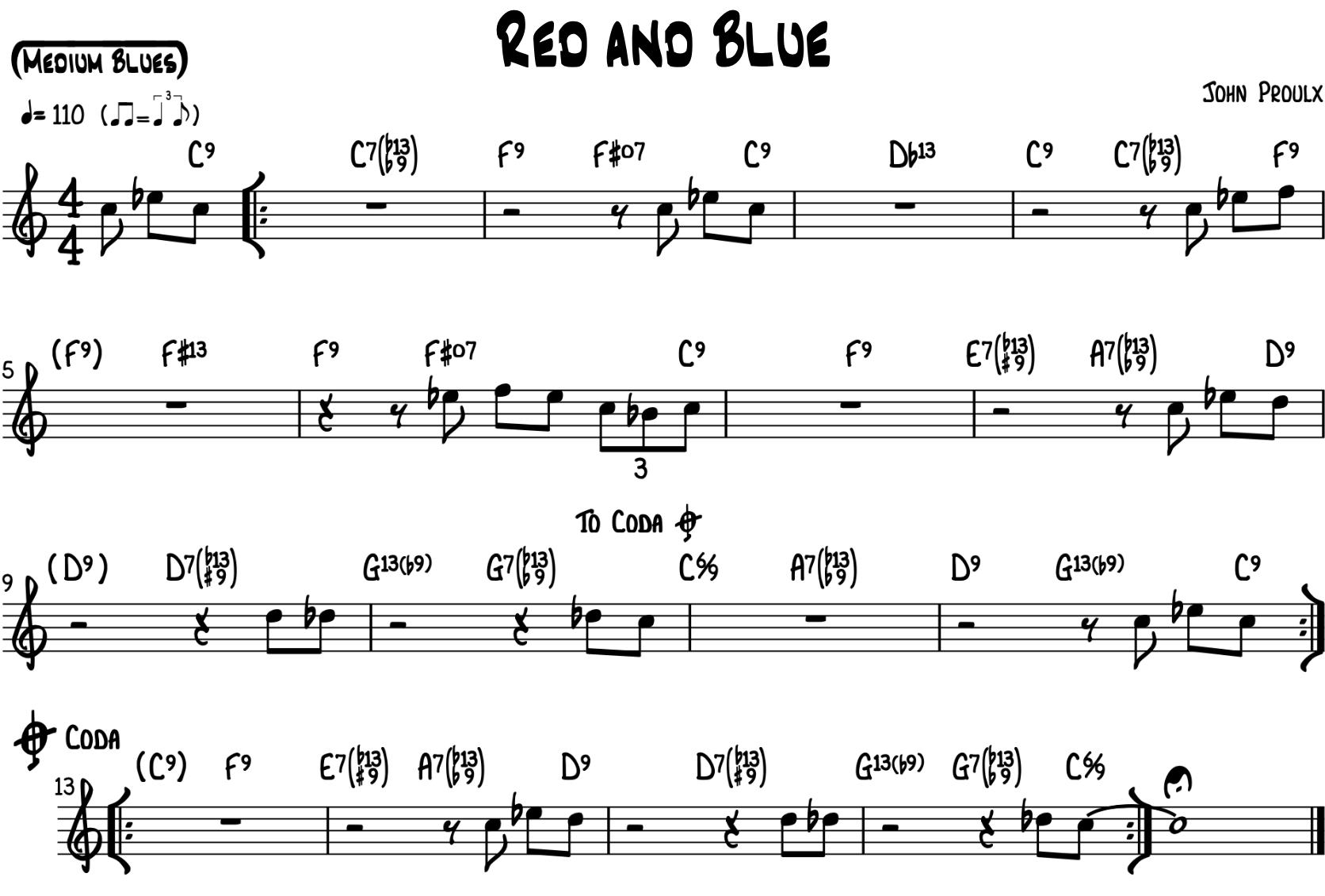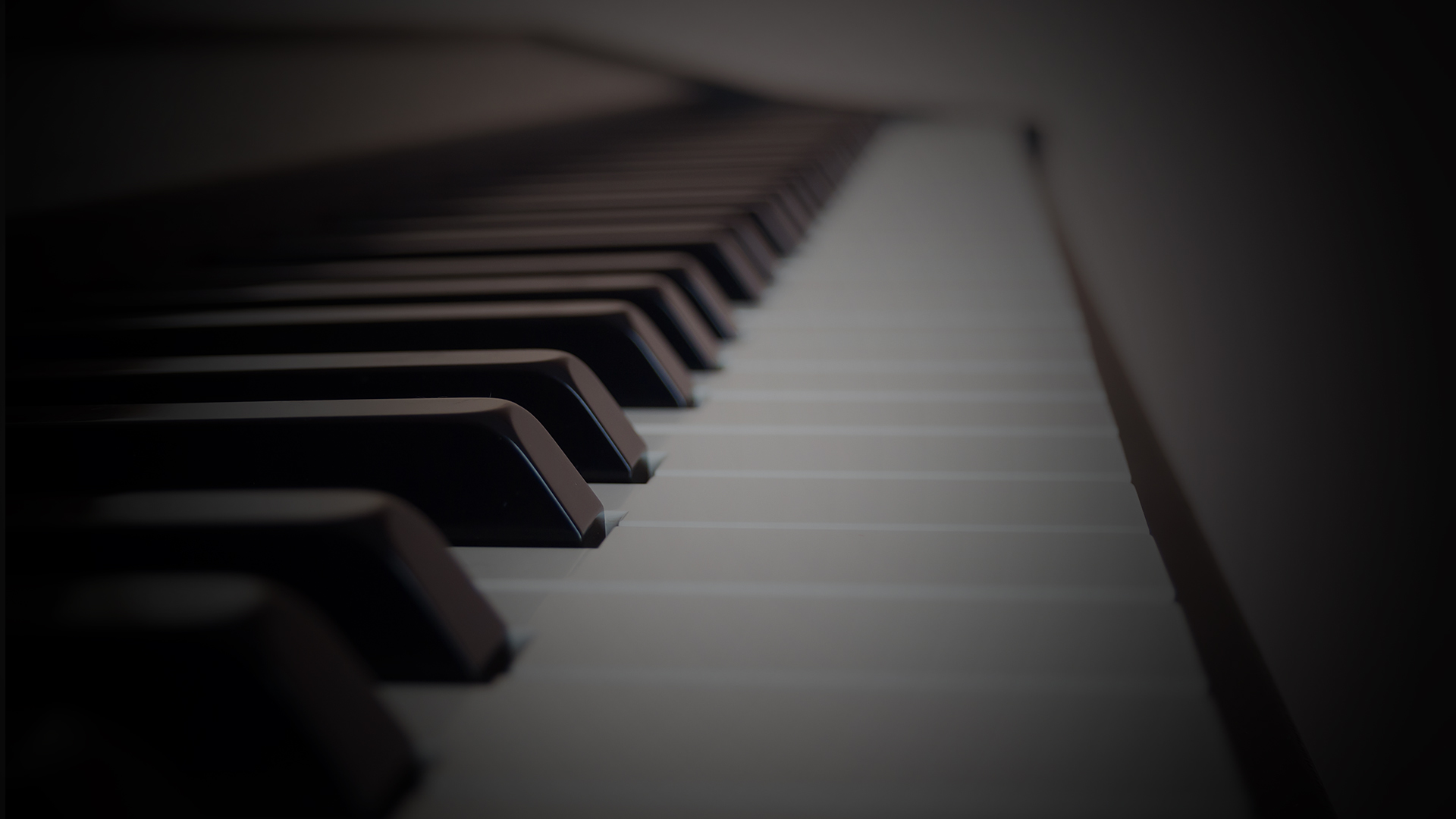How to Play In the Style of Red Garland
Learning Focus
Music Style
Free Lessons
Get free weekly lessons, practice tips, and downloadable resources to your inbox!
Red Garland was a master jazz pianist whose elegant playing style and musical sensibility has delighted and inspired jazz students and listeners for over a half-century. In today’s Quick Tip, How to Play in the Style of Red Garland, John Proulx shares pro tips that will help you imitate the classic jazz piano sound and style of Red Garland. You’ll learn:
Intro to Red Garland
Red Garland (1923–1984) was a popular American jazz pianist who rose to fame in the mid-to-late 1950s as both a sideman and a band leader. In particular, his role in Miles Davis’ First Great Quintet (1955–58) produced some of his most well-known recordings, which also helped to propel his career as a leader. That legendary ensemble featured Miles Davis on trumpet, John Coltrane on tenor saxophone, Red Garland on piano, Paul Chambers on bass, and Philly Joe Jones on drums.
Red Garland’s Playing Style
Red Garland’s playing style is simultaneously subdued and sophisticated, with an instinctive musicality. In particular, Red Garland is especially known for his frequent use of big and bright, two-handed block chord voicings, which he used as both a melodic texture and for punctuating accompaniment phrases. In addition, Red Garland displayed an intuitive sense of swing in his comping rhythms, which featured intentional anticipations of the strong beats. That is, Red frequently played his chords an 8th-note early—on the “and” of beat four and the “and” of beat two, instead of directly on beats one and three. Furthermore, Red Garland’s licks and improvised melodies displayed playful mastery of both blues and bebop vocabulary.
Lesson Overview
In today’s lesson, we’ll explore Red Garland’s signature playing style over an original blues tune by John Proulx entitled “Red and Blue.” Afterward, we’ll discover and apply three essential Red Garland piano techniques:
- Syncopated Comping
- Block Chords
- Bluesy Licks
The lead sheet for “Red and Blue” is shown below, which contains the original melody and chord changes. If you are a PWJ member, then you can download the complete lesson sheet PDF and backing tracks that have been designed to accompany this tutorial. These resources appear at the bottom of this page after logging in with your membership. In addition, PWJ members can also easily transpose the lesson sheet examples to any key using our Smart Sheet Music.
Original Blues Tune Inspired by Red Garland
“Red and Blue” is a 12-bar blues in C. However, you may be surprised by just how many chord changes there are in this little 12-bar tune. That’s because John is using a lot of passing chords to keep the harmony interesting, such as:
- diminished passing chords (F♯º7 in bars 2 and 6)
- tritone substitutions (D♭13 in bar 3, F♯13 in bar 5)
- secondary dominants (E7♯9♭13 in bar 8)
In the next section, we’ll examine three classic Red Garland jazz piano techniques and apply them to this tune.
Red Garland Piano Techniques
Red Garland is a great jazz pianist for piano students to listen to and imitate because his playing style is timeless and broadly applicable. Although Red Garland’s playing techniques are not necessarily simple, most intermediate level students who patiently study and practice his approach will find success in adopting his methods. In this section, we’ll unpack the three specific Red Garland techniques that we’ve been discussing: (1) rhythmic comping, (2) block chords, and (3) bluesy licks.
#1 – Red Garland Comping
You don’t have to listen to many Red Garland recordings before you hear him slip into his signature comping approach in which he plays short chords on the upbeats—specifically, on the “and” of beat four and beat two. It’s important to note that these chords are harmonic anticipations because they introduce the chord a half-beat earlier than it would typically appear on a lead sheet. In other words, with this approach, a chord printed on beat one is played on the “and of four” in the preceding measure. Similarly, a chord printed on beat three is played on the “and of two” instead. This technique creates a great feel and a sublime sense of swing that helps propel a tune forward.
The following example demonstrates Red Garland’s left-hand comping approach at a medium-swing tempo of 100 BPM. The voicing structure here employs the standard system of 4-note Type A and Type B rootless voicings that are studied by all aspiring jazz piano students.
L.H. Comping Example
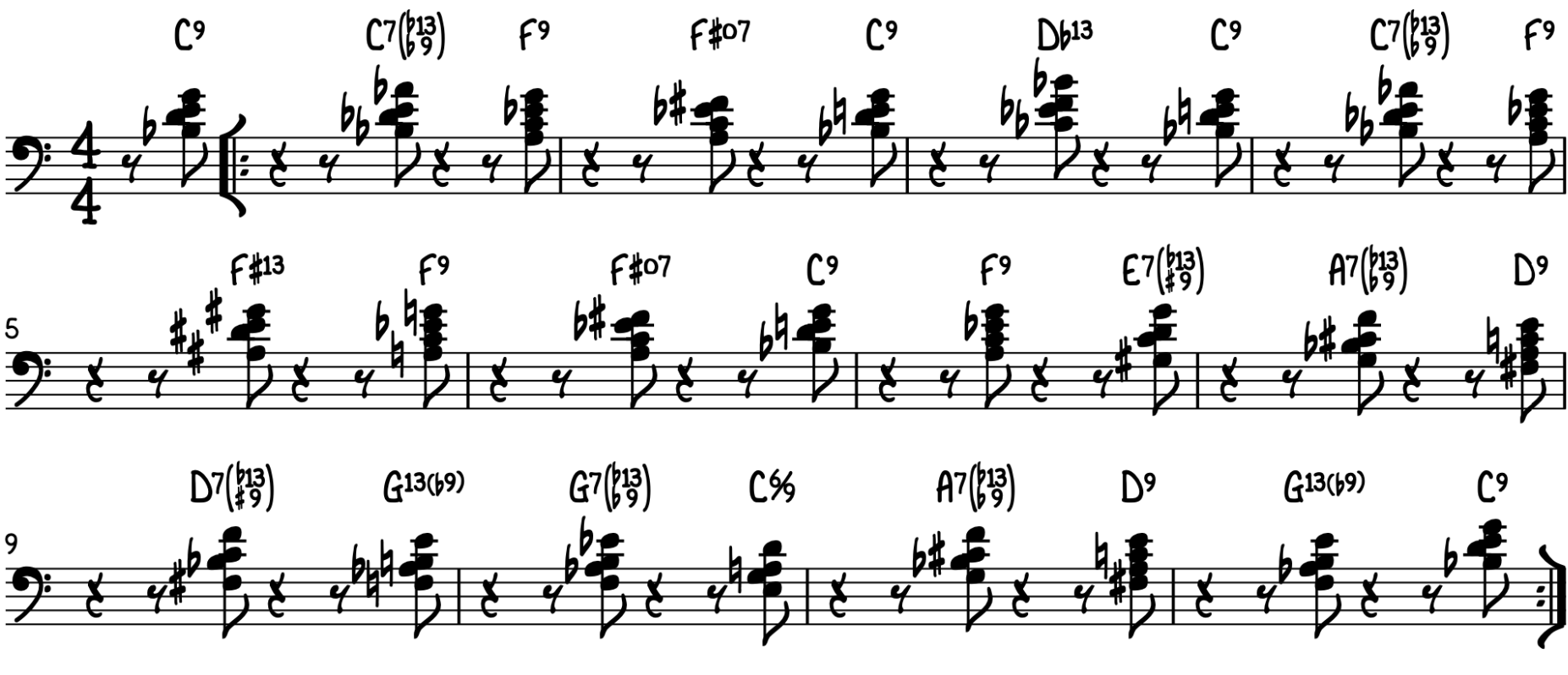
Next, let’s add the melody for “Red and Blue” in the right hand and listen to how the hands sound when played together with Red Garland comping.
Melody with L.H. Comping
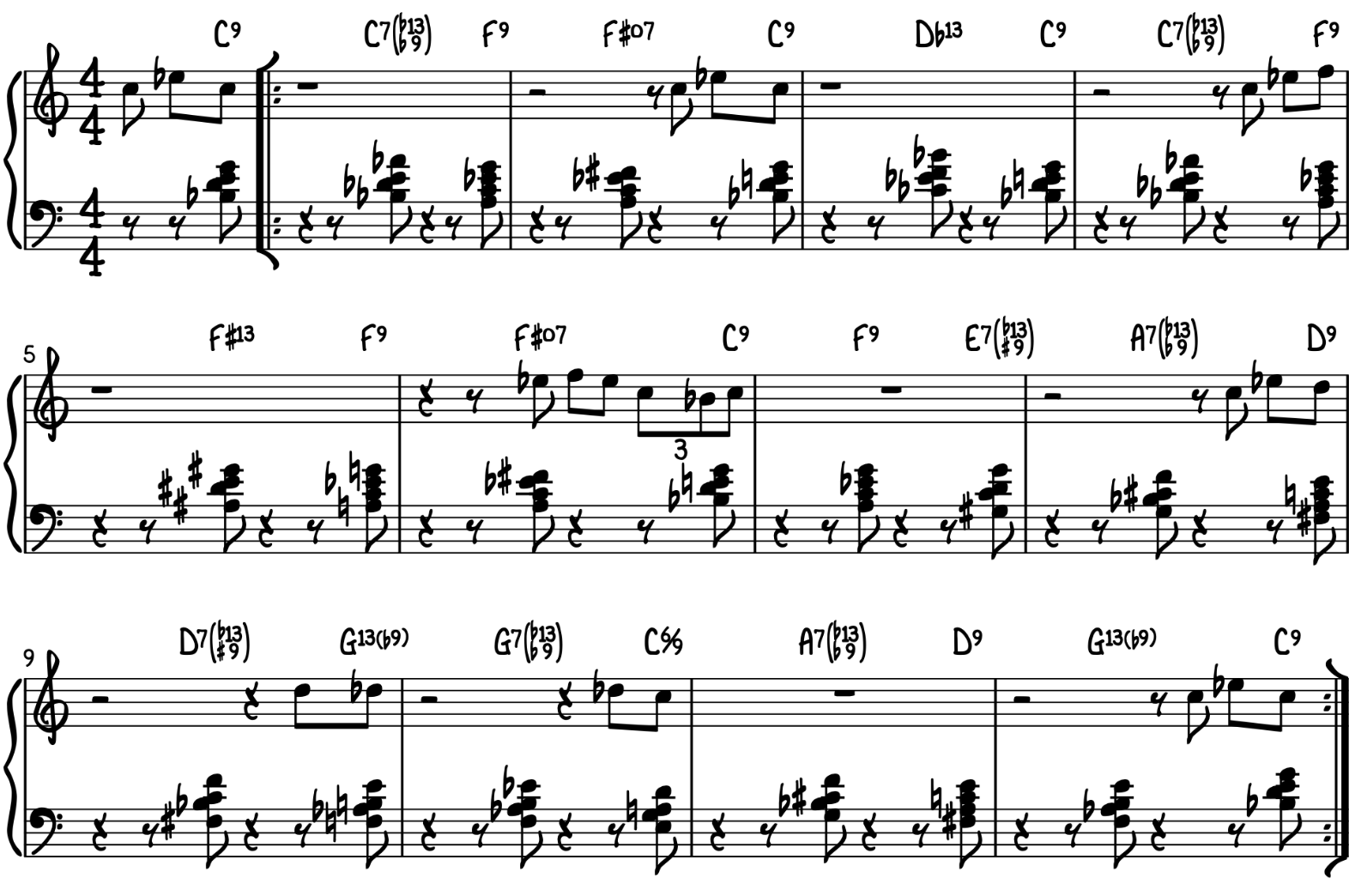
Next, let’s turn our attention to another Red Garland signature technique…block chords.
#2 – Red Garland Block Chords
Another signature sound of Red Garland’s playing style was his big and bright 7-note block chords, a technique which is also described as locked-hands because the hands play together rhythmically.
Note, the terms “block chords” and “locked hands” are often used with specific reference to the 5-note voicing approach popularized by pianist George Shearing. However, “block chords” and “locked hands” are also used in a broader sense to describe any voicing approach in which a pianist uses two hands to play melodies with a thick texture. In fact, jazz pianists like Milt Buckner, Nat “King” Cole, Oscar Peterson, Bill Evans, George Shearing and Red Garland all played in the locked-hands style with different types of block chord voicings.
In this section, we’ll examine the 7-note block chord voicing technique that has come to be known as “Red Garland voicings.” Other names for this voicing approach include spread voicings and shout-chorus voicings.
How to Construct Red Garland Block Chords
Red Garland’s 7-note block chord voicings can be constructed using the following three steps:
- Start with a standard 4-note Type A or Type B rootless voicings in the left hand.
- Voice the melody-note in octaves with the right hand in the upper register of the piano.
- Add an additional middle-note in the right hand between the octaves, either a minor 3rd or a perfect 4th below the top note. Preserve this interval relationship to the top note as the melody moves, even if the resulting middle-note is not technically in the chord.
One surprising aspect about Red Garland voicings is that the middle note in the right-hand sometimes “clashes” or “rubs” against the harmony from a purely theoretical perspective. However, since these melodic passages typically go by quickly, the so-called “Red Garland rub” actually sounds good!
In today’s lesson, all of the Red Garland block chord voicings use the interval of a minor 3rd below the top note to arrive at the middle note. Instances in which this middle-note conflicts with the prevailing chord symbol are indicated with an asterisk (*). That way, you’ll be able to listen for the Red Garland rub.
The Red Garland Rub
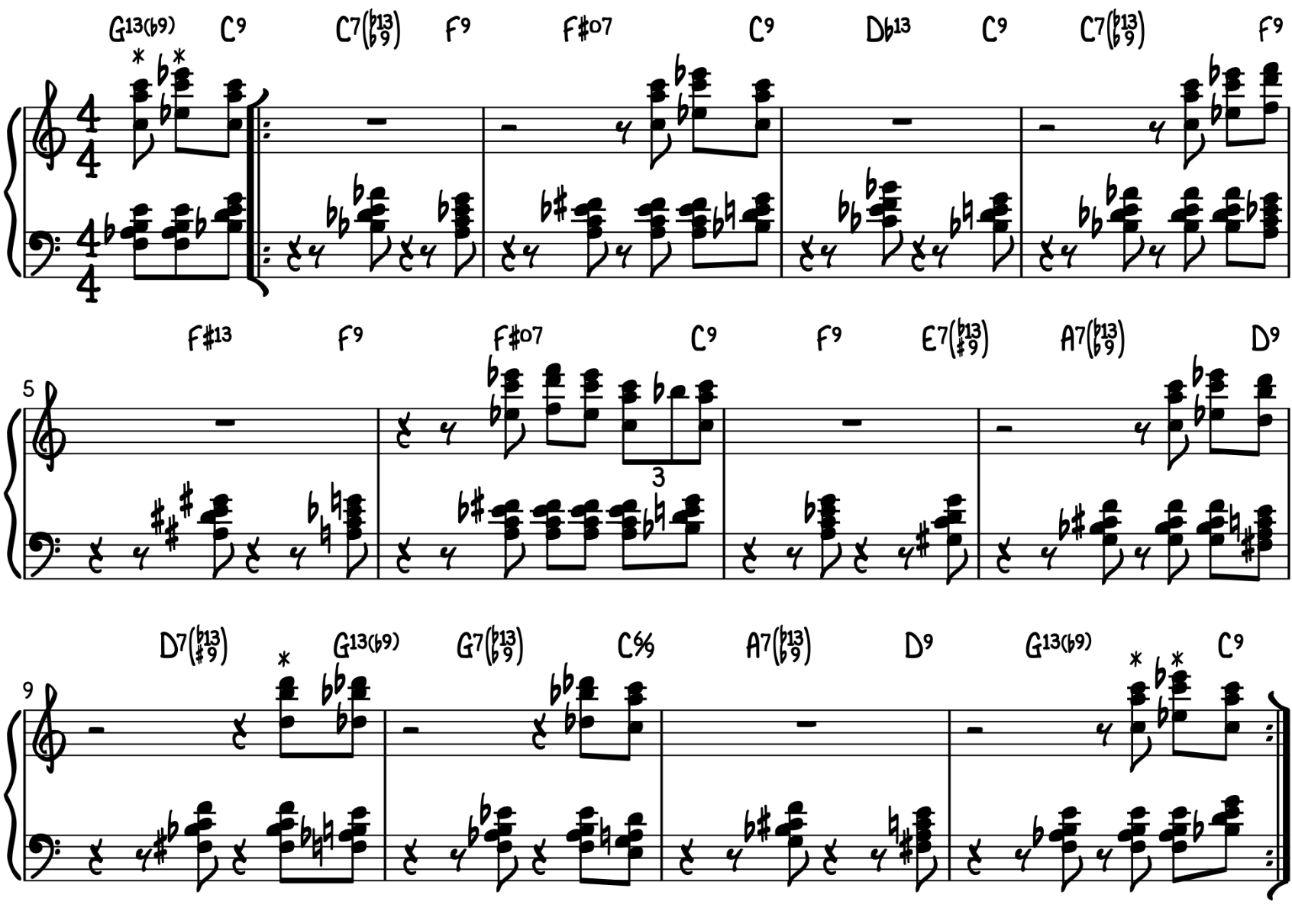
Next, we’ll play some bluesy piano licks inspired by Red Garland.
#3 – Red Garland Bluesy Licks
In this section, we’ll isolate four bluesy licks that are reminiscent of Red Garland’s improvisational playing style.
Lick 1
Lick #1 is based on the Mixo-blues scale and incorporates melodic ornamentation techniques such as top harmony and turns.

Next, let’s examine another Red Garland lick.
Lick 2
Red Garland Lick #2 also primarily comes from the Mixo-blues scale. This lick incorporates a particular melodic contour that we call an enclosure. In jazz improvisation, enclosure is a technique that approaches a target chord tone using both upper and lower neighbors. Enclosures can draw from diatonic neighbors, chromatic neighbors or both.

In Lick #2, the target note for the enclosure is the note G at the beginning of the 2nd full measure. This G is preceded by the notes F♯, A♮ and A♭ in the previous measure. These notes are all either diatonic or chromatic neighbor notes to G. Notice how the melody “circles” or “hovers” all around G before closing in on it. The result is a rather long example of an enclosure. Other terms for enclosure include encircling tones, rotations and surround notes.
For a deep dive on the topic of enclosures, check out the following full-length jazz improvisation course:
🔎 2-5-1 Soloing with Enclosures (Adv)
Now let’s examine another lick.
Lick 3
Red Garland Lick #3 is a simple lick that makes playful use of repetition.

Next, let’s examine one more lick.
Lick 4
Red Garland Lick #4 is a descending melody that draws primarily on the minor blues scale while playfully alternating between “on the beat” and “off the beat” phrasing concepts.

So far, we’ve played four bluesy Red Garland licks, but we’re not done yet. In the following example, we’ll apply these licks to a musical context using the chord changes for “Red and Blue.”
Red Garland Licks Over 12 Bar Blues
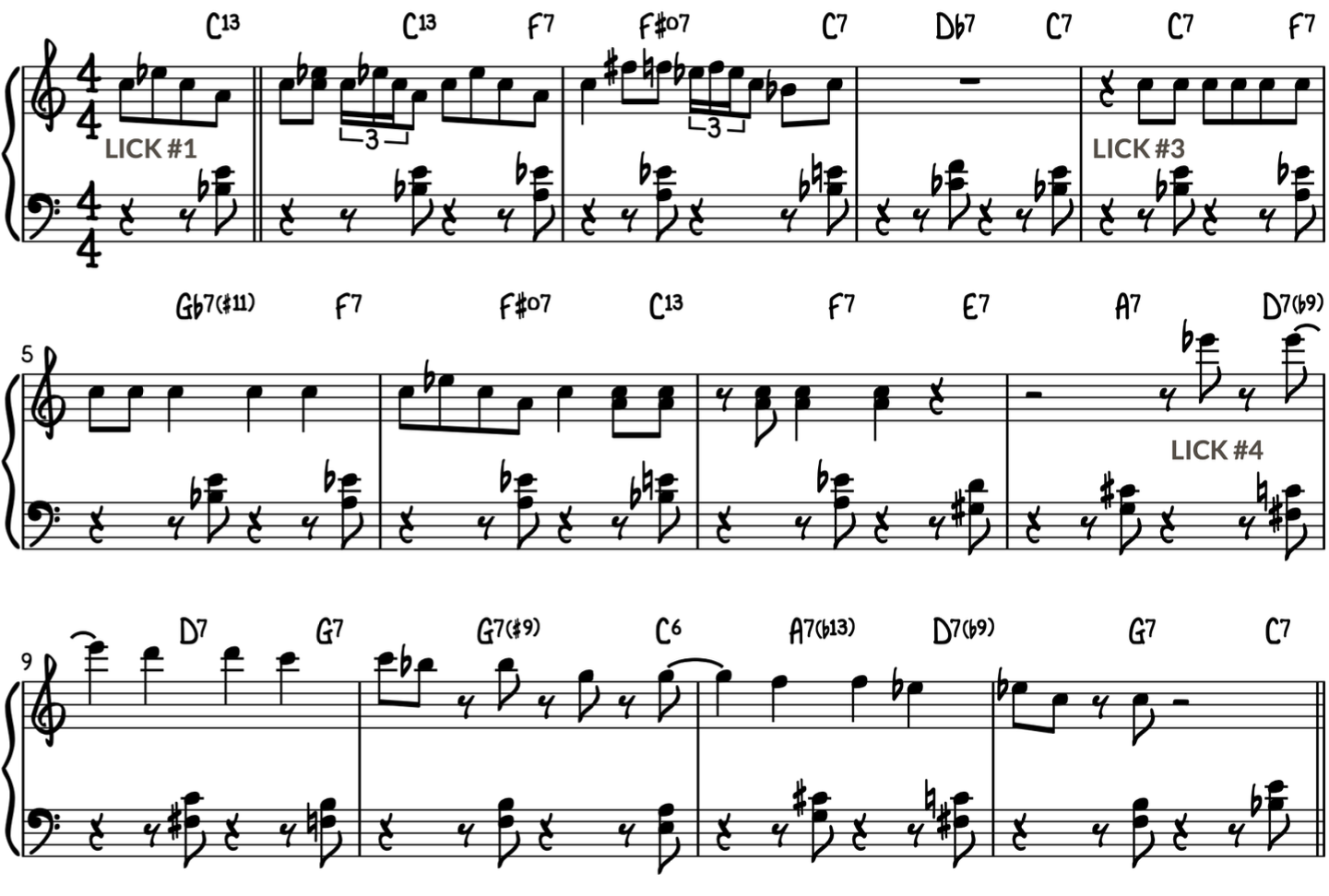
How great is that? Next, it’s your turn to put it all these Red Garland jazz piano techniques together in a final arrangement. The last pages of today’s lesson sheet PDF notate “Red and Blue” in the following manner:
- Chorus 1: “Red and Blue” single-note melody
- Chorus 2: “Red and Blue” melody in block chords
- Chorus 3: written-out solo with Red Garland licks
- Chorus 4: “Red and Blue” melody in block chords
- Coda: Tag bars 7–10 twice
Continue reading to learn more about the music, life and legacy of Red Garland.
Discover More About Red Garland
In this section of today’s lesson on How to Play in the Style of Red Garland, we’ll cover another important aspect to imitating any musician’s playing style—listening. Afterward, we’ll learn a bit more about the life and legacy of Red Garland.
Recommended Listening
Here are some hand-picked recordings that exemplify the signature Red Garland playing techniques outlined in today’s lesson. We’ve included samples of Red Garland’s work as a sideman and also as a band leader.
As a Sideman
Even though Red Garland became a respected band leader, he began his career as a sideman. With the exposure of each gig, Red gradually became more and more in demand as a player. In fact, Red Garland performed in New York and Philadelphia with top notch players including “Hot Lips” Page, Billy Eckstine, Eddie “Lockjaw” Davis, Charlie Parker, Fats Navarro, Dexter Gordon, Gene Ammons, Bennie Green, Coleman Hawkins, Roy Eldridge, Lester Young, Ben Webster, Sonny Rollins, Jackie McLean, Phil Woods and Curtis Fuller. However, his biggest break came in 1955 when he joined the Miles Davis Quintet and recorded with Miles, John Coltrane, Paul Chambers and Philly Joe Jones.
Here is a sample of Red Garland’s playing as a sideman in the mid-to-late 1950s.
John Coltrane
“Traneing In” (1957)
Miles Davis
“Billy Boy” (1958)
Coleman Hawkins
“It’s a Blue World” (1959)
As a Leader
Red Garland’s relationship with Miles Davis ended in January of 1959. However, Red had begun getting gigs with his own trio in the early 1950s and started recording in 1956 with Paul Chambers on bass and Art Taylor on drums. Red Garland also expanded his lineup to a quintet, producing three albums with John Coltrane and Donald Byrd. In all, Garland recorded 25 albums between 1956 and 1962 for Prestige Records. In addition, he recorded four albums with Riverside Records in the early 1960s.
Here is a sample of Red Garland’s playing as a band leader in the late 1950s and early 1960s.
Red Garland Trio
“September in the Rain” (1957)
Red Garland Trio
“There Will Never Be Another You” (1959)
Red Garland Quartet
“Sophisticated Swing” (1962)
Red Garland’s Life and Legacy
Red Garland was born in Dallas, TX in 1923 as William McKinley Garland, Jr. Despite his refined jazz piano style, Red Garland actually got a late start on the instrument. “You couldn’t call me a child prodigy,” he once remarked.¹ In fact, he didn’t start playing piano until after he joined the Army at age 18.² He also didn’t come from a particularly musical family. His father was an elevator operator. However, Red’s dad loved Benny Goodman and wanted Red to play clarinet. Consequently, clarinet was Red’s first instrument, followed by the saxophone.
Red joined the Army from 1941–1944, during which time he became captivated by the piano and began learning from his peers in the Army. Red was also a semi-pro boxer during this season of life and had considered making a career of it. Ultimately, Red chose the piano instead.
Much of Red Garland’s instinctive musical sensibility was acquired by imitating his predecessors and peers, including Art Tatum, Count Basie, Nat “King” Cole, and Ahmad Jamal. In addition, Red became close friends with Bud Powell. “I went over to Bud’s house, and he showed me some things. In fact, I came back day after day to learn from him, and we became buddies.”³
Despite Red’s success in the 1950s and early 60s, change was in the air. As rock ‘n’ roll became popular, sales of jazz records plummeted and many jazz clubs closed. Moreover, Red’s mother became ill. Consequently, Red entered into semi-retired in 1965 and moved to Dallas to care for his mother until her passing in 1968.⁴ Afterward, Red enjoyed a modest resurgence in the 1970s before his passing in 1984.
Beyond his tremendous contribution to the art of jazz, Red Garland was a husband to his wife Lillie, with whom he had two children.
Conclusion
Congratulations, you’ve completed this lesson on How to Play in the Style of Red Garland. After you master the skills in today’s lesson, you’re likely to find your own playing in high demand…just like Red!
If you enjoyed this lesson, then be sure to check out the following PWJ resources:
Courses
Jazz Swing Learning Tracks
Jazz Ballad Learning Tracks
Thanks for learning with us today! We’ll see you next time.
Would you like to comment on this lesson?
Visit this Quick Tip on YouTube
¹ Lyons, Leonard. The Great Jazz Pianists: Speaking of Their Lives and Music. 1st ed, W. Morrow, 1983, p. 146.
² “Red Garland.” AllAboutJazz.com, 2 Feb. 2024.
³ Lyons, Leonard. The Great Jazz Pianists: Speaking of Their Lives and Music. 1st ed, W. Morrow, 1983, p. 147.
⁴ Maxwell, Lisa C. “William (Red) Garland: A Jazz Legend’s Journey.” Www.tshaonline.org, Texas State Historical Association (TSHA), 1 Jan. 1995.
 Writer
Writer
Michael LaDisa
Michael LaDisa graduated from the University of North Texas with a major in Music Theory & Composition. He lives in Chicago where he operates a private teaching studio and performs regularly as a solo pianist. His educational work with students has been featured on WGN-TV Evening News, Fox 32 Good Day,...
More Free Lessons
Alma Deutscher shows us how to improvise a beautiful piano piece with just 4 notes randomly chosen from a hat.
Jacob Collier just played Stride Piano unlike anything I've heard, and it's incredible! I break it down for you so you can learn his tricks.
These are the 5 core reasons why students struggle to make their chords sound interesting.
Looking for downloads?
Subscribe to a membership plan for full access to this Quick Tip's sheet music and backing tracks!
Join Us
Get instant access to this Quick Tip and other member features with a PWJ membership!
Guided Learning Tracks
View guided learning tracks for all music styles and skill levels
Progress Tracking
Complete lessons and courses as you track your learning progress
Downloadable Resources
Download Sheet Music and Backing Tracks
Community Forums
Engage with other PWJ members in our member-only community forums
Become a better piano player today. Try us out completely free for 14 days!


